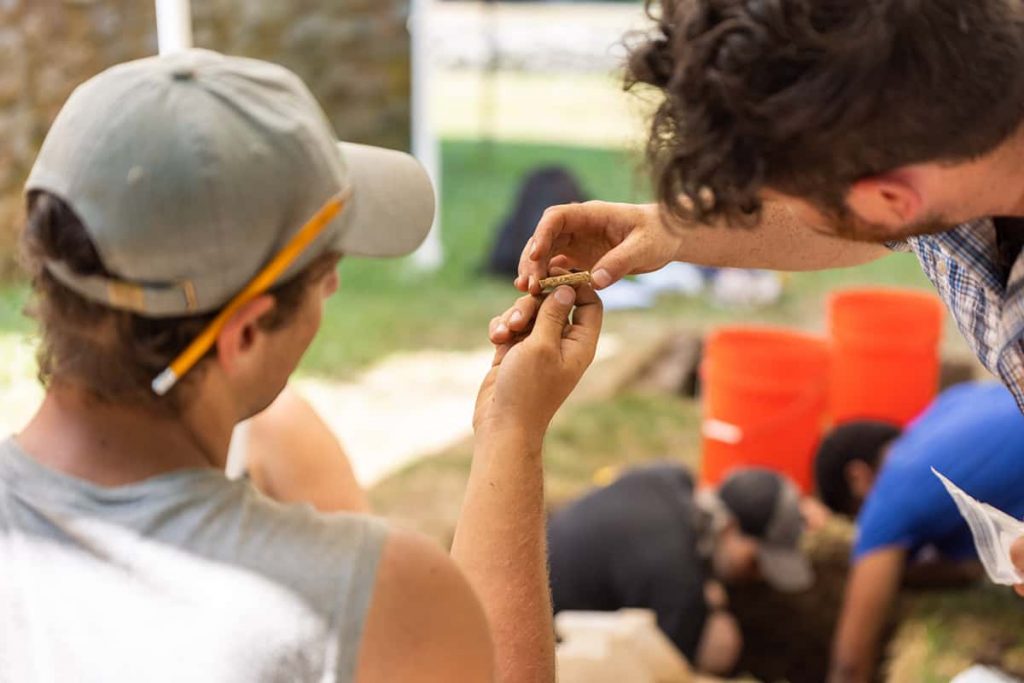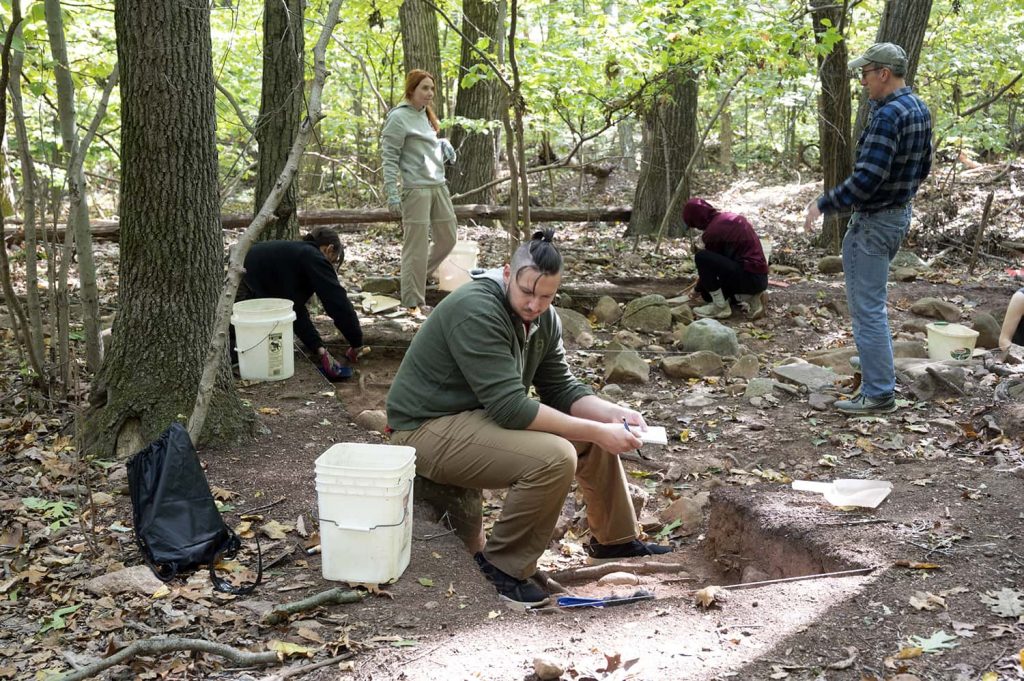Charmaine Robichaud, ’24, who’s known as Charlie, has loved animals since she was young, and this love has grown into a fascination with excavating and cataloging their skeletons.
“I just want to go where the bones take me, basically,” said Robichaud, who lives in Woodbridge, Conn.
This fall, she’ll have the opportunity to follow her passion into a graduate degree: Southern’s new master’s program in archaeology and cultural resource management.
Since January, Robichaud has been working in Associate Professor William Farley’s lab in the Anthropology Department. “I was just cataloging artifacts, and he needed me to essentially be a specialist,” she said.
Farley, who is the coordinator of the master’s program, and his students have been excavating a site at the 17th-century Henry Whitfield State Museum in Guilford, the oldest house in Connecticut.
“All the artifacts are dug up during our field school that takes place in the summer, and then all those artifacts are transported to the lab at Southern for processing and bagging and tagging and cataloging,” Robichaud said.
That’s where her cataloging expertise comes in.
“Dr. Farley would also have me come in and then ID all the bones that have been excavated, or previously cataloged,” Robichaud said.

The master’s program, which launches in the fall semester, will give Robichaud and up to 12 other students a chance to get the broad-based learning any archaeologist needs.
“There really is no way before now for students to get a local graduate education in archaeology in the state of Connecticut,” Farley said. The only options were doctoral programs at Yale or the University of Connecticut. “So this is really the first program for that.”
Farley said the key aspect of the program is the cultural resource management aspect.
“For students who want to study archaeology, really anywhere in the world, and who want to maybe go on to doctoral programs, or who want to work in the industry of archaeology, that’s what CRM, that cultural resource management program part, is,” he said.
He explained that there are opportunities to work in the field in private industry and museums, as well as in state government.
“People don’t probably realize that there is actually a whole industry you can go into in archaeology,” he said. “There are laws that protect cultural heritage, and those require private companies and public oversight and all sorts of institutions that do archaeological digs and archaeological research to protect that heritage. And those create jobs.”
Companies have had to rely on out-of-state archaeologists, Farley said. In developing the new program, the Anthropology Department was “reacting to that labor need,” Farley said, “but also [for] people who maybe wanted to study archaeology anywhere in the world, but didn’t have a local option for that.”
Farley said he and his colleagues also hope that some students who are interested in studying human evolution in Africa or perhaps the medieval period in Great Britain might pursue the master’s before going on for a PhD. In addition to the site in Guilford, the department has field programs in England and Ethiopia.
“If you walk away with a master’s in archaeology … you can be a hired trowel anywhere in the world,” said Kathleen Skoczen, chair of the Anthropology Department. “You can look for work not only in Connecticut, but if you’re interested in going elsewhere.”
The program is also an accelerated one, so students can start their master’s while still undergraduates, she said.
“We’re really trying to … make it more accessible,” Skoczen said. “Make sure that someone from New Canaan has the same access to getting an archeology degree as someone from Bridgeport.”

Known as “public archeology” in other countries, cultural resource management is “the industry of essentially commercial archeology,” said Anthropology Professor Michael Rogers.
As with environmental impact statements, Rogers said, “You’re required to do a cultural impact statement whenever a construction job or infrastructure project is happening, especially if it’s federally and/or state funded; this is a required step in the process.”
Companies have told him and others, Rogers said, that they have lots of contracts for infrastructure projects, such as highway jobs, and say that they “can’t hire enough people,” especially as project supervisors.
Farley said other areas of potential employment include “energy projects, pipelines, but also the USDA hires a lot of archaeologists because when farmers have federal farm loans, they have to do cultural assessments if they’re going to do work on their property. … The National Park Service hires thousands of archaeologists in parks across the country.”
An example is a bridge expansion in Avon, Conn., where a 12,600-year-old Native American site was found, “the oldest Native American site in the state of Connecticut,” Farley said.
Other opportunities for internships and full-time jobs include the Yale Peabody Museum, the Mashantucket Pequot Museum, the Institute of American Indian Studies, and the State Historical Preservation Office, Farley said. New York and Boston have city archaeologists on staff.
Skoczen said the new program “takes our department to the next level. The anthropology program at Southern Connecticut State University is the most comprehensive in the state system. … We cover the whole discipline. We do have a lot of strength in archaeology. … So we are building on the depth in that department.”
Robichaud, who is now working as a resource assistant at the Osborne Homestead Museum in Derby, says she is excited for the new program. “I wasn’t sure where I wanted to go to grad school,” she said, but her close proximity to campus, her familiarity with the Southern faculty, and the affordability of the program were deciding factors in her choice of the new Southern master’s. Her ultimate goal is to be a professor.


